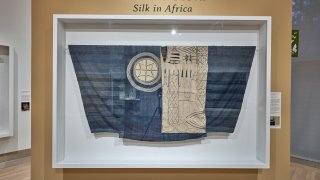
Silk is not typically associated with Africa, but the luxurious cloth has been produced there for centuries. Moth to Cloth: Silk in Africa, an exhibition at the Dallas Museum of Art (DMA) now on view through Oct. 24, explores the sub-Saharan tradition of silk production through indigenous and imported practices.

The focused exhibition features large-scale cloths from the DMA’s permanent collection.
Master weavers and other specialists from the Asante peoples of Ghana, the Hausa, Nupe and Yoruba peoples of Nigeria as well as the Malagasy peoples of Madagascar created the examples of silk on display at the museum.
Short films streaming in the gallery show the life cycle of silkworms and how silk is harvested and woven into cloth.
In Africa, fibers were acquired through trade and cultivation or were harvested from cocoons found in the forest. Silk garments with distinctive patterns and colors are worn for ceremonial events and by the most prestigious people in society.
Dr. Roslyn A. Walker, the DMA’s Senior Curator of the Arts of Africa, the Americas and the Pacific, The Margaret McDermott Curator of African Art and curator of this exhibition, talks about silk in Africa, its attributes, and its influence around the world.
The Scene
NBC DFW: How is African silk different from silk from other parts of the world? How is it similar?
Dr. Roslyn A. Walker: First, it should be remembered that African silk comes from either wild or domesticated moths. Both types are found in Madagascar. Wild landibé silkmoths (from species of moth from the genus Borocera) produce silk that is naturally earth-toned, strong, and rough-textured compared to that from domesticated mulberry or “China” silkmoths, which is lustrous, smooth and easy to dye. (Mulberry silkmoths were introduced to Madagascar in the early 19th century from China and feed on white mulberry leaves.) Wild silkmoths belonging to the Anaphe and Epanaphe genera are indigenous to Nigeria where they have not been domesticated. Hunters find the cocoons in the forest and sell them to the textile specialists. The silk produced from these silkmoths is heavier than China silk and tends to be dull and textured like homespun cotton. Like China silk, all African silks are significant and prestigious because their acquisition is historically beyond the means of ordinary people.
NBC DFW: This exhibition features silk textiles from Ghana, Nigeria and Madagascar. How are these silk garments from these different parts of Africa distinctive from each other?
Dr. Walker: The garments from Ghana and Madagascar are rectangular cloths that are worn wrapped around the body, like a man’s toga or a woman’s wrapper (Ghana) or draped over the shoulders (Madagascar). The voluminous garment from Nigeria is tailored and worn like a gown. Distinctive patterns, designs, and colors in the weaving and intricate embroidered designs distinguish the cloths.

NBC DFW: What does silk from Africa say about the historic trade routes and its influence on African culture and Africa's cultural impact on the world?
Dr. Walker: The historic trans-Saharan, coastal, and internal trade routes brought new products, materials, technologies, new religions, and ideas from the world beyond continental Africa. The exchange was mutually beneficial but also detrimental to Africa, e.g., the trans- Atlantic slave trade and colonialism. Among Africa’s many cultural contributions are the various textile patterns, including those produced in silk, which for more than a century have long inspired Western designers of haute couture and home furnishings.
NBC DFW: These garments were used for ceremonial events, worn by distinguished people. What is it about silk that makes it a material of importance?
Dr. Walker: In the distant past, silk was difficult to obtain, and in the present, it remains a precious material. Silk cloth might have reached the interior of Africa on camels crossing the Sahara Desert or in ships plying the Atlantic coast, both lengthy and infrequent journeys. Imported goods such as silk textiles were usually gifted to the leadership of a kingdom or village, not to ordinary people. Although imported silk thread has been replaced by rayon or cotton for over fifty years now, genuine silk remains the material of choice for making prestigious garments that symbolize elevated social/political status, success, and wealth. This is particularly true in Ghana, where kente, woven with imported silk threads, remains the prerogative of the Asantehene (king of the Asante), and in Nigeria, where sanyan cloth is woven with thread produced by wild silkworms for the great “gowns of honor” presidents, chiefs, and elites. Wherever silk is produced, the care and feeding of silkmoths to produce silkworms, and then subsequently transforming cocoons into silk threads, is a human labor-intensive process.

NBC DFW: What most surprises you about silk from Africa?
Dr. Walker: Initially, a long time ago (sometime in the late 1960s or early 1970s), I was surprised to learn that there was such a thing as “African silk”. Now, I am surprised that contemporary African silk products are not readily available in the USA.
Learn more: https://dma.org/MothtoCloth



